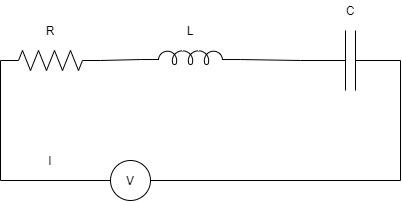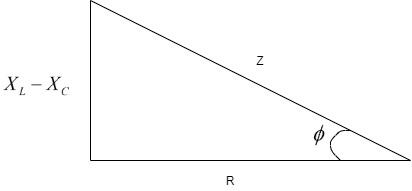
If the power factor in a circuit is unity, then the impedance of the circuit is
A. Inductive
B. Capacitive
C. Partially inductive and partially capacitive
D. Resistive
Answer
572.4k+ views
Hint: It is important to know the definition of power factor for solving this question. The power factor is defined as the ratio of the real power absorbed by the load to the apparent power flowing in the circuit. It is a dimensionless number ranging from -1 to +1.
Complete step by step answer:
Consider the following LRC circuit connected to an AC source of voltage $V = {V_0}\sin \omega t$ where $\omega $ is the angular frequency, $\omega = 2\pi f$:

The impedance, Z is defined as the resistance offered to the flow of alternating current I through the entire circuit. Here, in the figure, the impedance Z is the vector sum of the reactances of the individual resistance, inductor, and the capacitor.
Capacitive reactance, ${X_c} = \dfrac{1}{{\omega C}}$
Inductive reactance, ${X_L} = \omega L$
Resistance is $R$.
Impedance, $Z = R + \left( {{X_L} - {X_C}} \right)$
These quantities cannot be added in a scalar manner since they have different phases. We have to add these values through vector addition by drawing the impedance triangle with $\phi $ as the phase angle.

Thus, we can see that the Z is the vector sum of the reactance and the resistance as the triangle.
${Z^2} = {R^2} + {\left( {{X_L} - {X_C}} \right)^2}$
Here, the value of $\cos \phi $ is called the power factor, which gives the ratio of the real power that the load absorbs and the apparent power that the circuit absorbs.
Power factor = Real power / Apparent power
Power factor = $\dfrac{{{I^2}R}}{{{I^2}Z}}$
Therefore, from the figure, we can write that, Power factor = $\dfrac{R}{Z} = \cos \phi $
For the power factor to be one, $\cos \phi = 1$
where, $R = Z$
Substituting in the impedance equation, we get –
$
{Z^2} = {R^2} + {\left( {{X_L} - {X_C}} \right)^2} \\
\Rightarrow {R^2} = {R^2} + {\left( {{X_L} - {X_C}} \right)^2} \\
\Rightarrow {\left( {{X_L} - {X_C}} \right)^2} = 0 \\
\therefore {X_L} = {X_C} \\
$
Here, we see that inductive and capacitive reactance is equal and thus, they cancel out each other. When they cancel out, only the resistance stands out.
Thus, the circuit where only resistance acts is called a resistive circuit. Hence, the correct option is Option D.
Note:
Some students may get confused as to why we have taken $\left( {{X_L} - {X_C}} \right)$ and not $\left( {{X_C} - {X_L}} \right)$. This arises from the fact that in this problem, the circuit is assumed generally, to be inductive. However, in the problem, if we have a capacitive circuit, we should consider the expression $\left( {{X_C} - {X_L}} \right)$.
Complete step by step answer:
Consider the following LRC circuit connected to an AC source of voltage $V = {V_0}\sin \omega t$ where $\omega $ is the angular frequency, $\omega = 2\pi f$:

The impedance, Z is defined as the resistance offered to the flow of alternating current I through the entire circuit. Here, in the figure, the impedance Z is the vector sum of the reactances of the individual resistance, inductor, and the capacitor.
Capacitive reactance, ${X_c} = \dfrac{1}{{\omega C}}$
Inductive reactance, ${X_L} = \omega L$
Resistance is $R$.
Impedance, $Z = R + \left( {{X_L} - {X_C}} \right)$
These quantities cannot be added in a scalar manner since they have different phases. We have to add these values through vector addition by drawing the impedance triangle with $\phi $ as the phase angle.

Thus, we can see that the Z is the vector sum of the reactance and the resistance as the triangle.
${Z^2} = {R^2} + {\left( {{X_L} - {X_C}} \right)^2}$
Here, the value of $\cos \phi $ is called the power factor, which gives the ratio of the real power that the load absorbs and the apparent power that the circuit absorbs.
Power factor = Real power / Apparent power
Power factor = $\dfrac{{{I^2}R}}{{{I^2}Z}}$
Therefore, from the figure, we can write that, Power factor = $\dfrac{R}{Z} = \cos \phi $
For the power factor to be one, $\cos \phi = 1$
where, $R = Z$
Substituting in the impedance equation, we get –
$
{Z^2} = {R^2} + {\left( {{X_L} - {X_C}} \right)^2} \\
\Rightarrow {R^2} = {R^2} + {\left( {{X_L} - {X_C}} \right)^2} \\
\Rightarrow {\left( {{X_L} - {X_C}} \right)^2} = 0 \\
\therefore {X_L} = {X_C} \\
$
Here, we see that inductive and capacitive reactance is equal and thus, they cancel out each other. When they cancel out, only the resistance stands out.
Thus, the circuit where only resistance acts is called a resistive circuit. Hence, the correct option is Option D.
Note:
Some students may get confused as to why we have taken $\left( {{X_L} - {X_C}} \right)$ and not $\left( {{X_C} - {X_L}} \right)$. This arises from the fact that in this problem, the circuit is assumed generally, to be inductive. However, in the problem, if we have a capacitive circuit, we should consider the expression $\left( {{X_C} - {X_L}} \right)$.
Recently Updated Pages
A man running at a speed 5 ms is viewed in the side class 12 physics CBSE

The number of solutions in x in 02pi for which sqrt class 12 maths CBSE

State and explain Hardy Weinbergs Principle class 12 biology CBSE

Write any two methods of preparation of phenol Give class 12 chemistry CBSE

Which of the following statements is wrong a Amnion class 12 biology CBSE

Differentiate between action potential and resting class 12 biology CBSE

Trending doubts
What are the major means of transport Explain each class 12 social science CBSE

Which are the Top 10 Largest Countries of the World?

Draw a labelled sketch of the human eye class 12 physics CBSE

How much time does it take to bleed after eating p class 12 biology CBSE

Explain sex determination in humans with line diag class 12 biology CBSE

When was the first election held in India a 194748 class 12 sst CBSE




